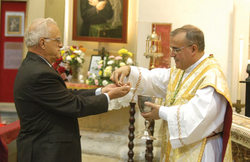[My diocese, like many, has instituted new guidelines for receiving Holy Communion, amid growing concerns about the H1N1 virus. One of those is the suggestion that Catholics, at least until the spring, only receive in the hand, not on the tongue. Some people in my parish are balking at that. Others do it, but haphazardly. So I decided to offer the reflection below, which was published this week in our parish bulletin.]
Once, there was no question, and no choice.
When I was first receiving communion in the mid-1960’s – and when a lot of Catholics of A Certain Age were starting to receive – you knelt and received the slender white wafer on your tongue. To touch The Body of Christ with your hands was unthinkable. Only the priest could do that. Right?
How times have changed.
 In the wave of reforms instituted after Vatican II, one significant change involved receiving communion in the hand. In 1969, Pope Paul VI granted permission to receive the wafer in the hand, echoing the ancient instructions of St. Cyril of Jerusalem, who wrote around the year 350 A.D.: “When you approach Holy Communion, make the left hand into a throne for the right, which will receive the King. Then with your lower hand, take the consecrated Host and place it in your mouth.”
In the wave of reforms instituted after Vatican II, one significant change involved receiving communion in the hand. In 1969, Pope Paul VI granted permission to receive the wafer in the hand, echoing the ancient instructions of St. Cyril of Jerusalem, who wrote around the year 350 A.D.: “When you approach Holy Communion, make the left hand into a throne for the right, which will receive the King. Then with your lower hand, take the consecrated Host and place it in your mouth.”
Sounds familiar, doesn’t it?
Anyway: I think it’s worth revisiting all this now, as Bishop DiMarzio is asking the faithful to receive in the hand to avoid spreading the increasingly worrisome H1N1 virus (better known as swine flu).
I can’t disagree with his reasoning; the bishop is also asking us to refrain from shaking hands during the “sign of peace” and to not share the chalice containing the Precious Blood. If you look around the country, you’ll see that other dioceses, and other denominations, are taking the same precautions.
But I think this also presents a good opportunity for us to think more deeply and more prayerfully about why we receive communion this way – and how we can grow in our appreciation for this form of taking the eucharist.
I started receiving it in the hand decades ago because it seemed simpler and, frankly, a little more daring. (In the early ’70s, when this became popular, tambourines and drums at mass were daring, too. But I digress…) Over time, it just seemed more natural and more comfortable.
But we shouldn’t forget that this form of reception is an invitation, and a challenge. It requires a kind of consciousness and participation. When we take communion in the hand, we offer our hands outstretched, like the humble beggars that we are. We do not just receive; we extend ourselves to accept a graciously offered gift – in fact, the greatest gift of all, Christ himself. We then complete the action by bringing this gift into ourselves. What began at the altar of sacrifice, at the hands of the priest, becomes complete in our own hands, with our own “Amen,” and our own consuming of the Body of Christ. Something profound is offered – and, significantly, taken.
In the words of the popular Spanish hymn: “We become what we receive.” Speaking for myself, I think that receiving in the hand makes that sacramental truth even more powerful.
Of course, receiving communion in the hand also asks us to be more keenly aware of what we are doing, and why.
Pope Paul’s 1969 instruction on this, Memoriale Domini, sums it up beautifully:
“The option offered to the faithful of receiving the Eucharistic bread in their hand and putting it into their own mouth must not turn out to be the occasion for regarding it as ordinary bread or as just another religious article. Instead this option must increase in them a consciousness of the dignity of the members of Christ’s Mystical Body, into which they are incorporated by baptism and by the grace of the Eucharist. It must also increase their faith in the sublime reality of the Lord’s body and blood, which they touch with their hand.”
Forty years later, as more of us receive this sacrament this way, it’s still a message we need to hear.

